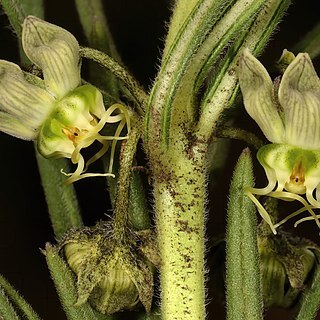Perennial, geophytic herb, 100-350 mm high. Leaves crowded, rarely scattered and irregularly inserted on lower non-flowering part of stem, verticillate at flowering nodes, leaves at flowering nodes not reduced in size, blade 17-45 x 1-2 mm, narrowly linear, subsessile, apressed-pilose. Inflorescence in fasicles of 2-6 at distal 2-5 nodes Flowers: pedicels up to 10 mm long; corolla lobes 4.5-6.5 x 2.5-3.5 mm, spreading to reflexed at anthesis, green, dorsal surface pilose, hairs hyaline patent and brownish appressed; corona basal lobes 1.5 mm long, compressed-ovoid with 2 shallow concavities on ventral face, apical processes curving to the right and overlapping forming a loose wreath above gynostegium, white with deep green base and margins. Flowering time Nov.-Feb. Fruit?

